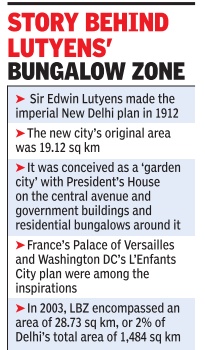Delhi: Lutyens
This is a collection of articles archived for the excellence of their content. |
Lutyens' vision

The Times of India, Aug 29 2015
Lutyens planned Delhi with a garden city in mind
When Sir Edwin Lutyens sat down at his drawing board to design Imperial New Delhi just over 100 years ago, he was inspired by the ideas of the Garden City Movement started by another English architect, Ebenezer Howard, in the late-1800s. The movement, an urban planning concept, saw a city as a group of planned, self-contained communities surrounded by green belts “containing proportionate areas of residence, industry and agriculture“. So Lutyens' Delhi, also known as the “Eighth City of Delhi“, stood out from the start with wide tree-lined avenues, large plots and spacious bungalows set in them. The President's House was set on a central avenue surrounded by government buildings and residential bungalows.
Lutyens unveiled his plan in 1912 and the new city , occupying 19.12 sq km, was built over 20 years. Located to the south of Shahjahanabad, it quickly became the seat of the rich and influential.
“The city was laid out in a grand manner and is an excellent example of a fine blend of classical and modern town planning. It lay on an east-west axis, starting at Rashtrapati Bhavan atop Raisina Hill and terminating at the India Gate `C' hexagon, said an official.
Even Delhi's hot and dry summers were factored into the design.“Rashtrapati Bhavan, North Block and South Block, large bungalow plots and other government buildings knit together carefully by a web of wide shady avenues lend to the city a grand order, symmetry and unique aesthetic character, says a description of Lutyens' Bungalow Zone (LBZ).
Besides the Garden City Movement, France's Palace of Versailles and Washington DC's L'Enfants City plan also provided Lutyens with inspiration. The hundreds of bungalows were designed by well-known British architects like WH Nicholls, CG Blomfield, Walter Sykes George and Arthur Gordon Shoosmith.
Experts say LBZ is unique and the only `new town' in the world inspired by the (much-modified) Garden City Movement. But the urban development ministry says LBZ should not be compared to Howard's `garden city' because it was envisaged as a suburb to a central city, while LBZ is the heart of New Delhi.
Swachh Survekshan
2017, NDMC 7th cleanest
Alok K N Mishra, New Delhi cleanest in north: Swachh survey, May 05 2017: The Times of India

The New Delhi Municipal Council (NDMC) area was declared the cleanest in the north, based on solid waste management, access to sanitation and other parameters of cleanliness, under the zone-wise Swachh Survekshan 2017.
NDMC finished seventh among 434 cities in the national ranking, slipping three notches from the fourth position it had bagged among 73 cities in 2016 and eight points above the 15th position it got in 2014.
NDMC is responsible for civic amenities in the 42.7 sq km area covering Lutyens' Delhi, besides Connaught Place and residential areas like Moti Bagh, INA Colony , Jor Bagh, Kidwai Nagar and others.NDMC secured 1707.96 out of 2,000 on various parameters in the survey conducted by the urban development ministry . The NDMC area has be come 100% open defeca tion free -the practice was earlier seen in slums located in Moti Bagh and some other places.
NDMC scored 819.95, 426.88 and 461.13 under municipal documentation, direct observation and citizen engagement, respectively . The council is elated, but chairman Naresh Kumar is gunning for the first position in Swachh Survekshan 2018 for which he has asked the officials to step up efforts.
NDMC has also devised a strategy to achieve top position. An official said the strategy for 2017-18 will be to segregate 100% waste at source from June 5. “We have decided to make five colonies zero-waste colonies.“ NDMC has already constructed 330 public toilets, 63 public toilets are under construction which will be completed by September . “We have become the first open urination free city,“ said an official.
To check waste generation in the form of plastic bottles, NDMC is installing water ATMs at public places. To improve its public toilets, NDMC will install machines for public feedback at public utilities to improve the level of maintenance and citizens' perception.
A door-to-door waste collection system covers the entire area of NDMC and over 75% of all notified commercial areas are swept twice a day using mechanised sweepers.
NDMC spokesperson M S Shehrawat told TOI: “The urban development ministry has observed that a slide in ranking does not mean that we had compromised in extending quality civic services to citizens and did not maintain the upkeep of cleanliness at par with the previous year.“
For awareness campaign and behaviour change, one of the key parameters, NDMC got 33 out of 50. NDMC claimed that it has undertaken an extensive campaign to create awareness about the segregation of waste at source. “Members of RWAs, volunteers of NGOs and students are going household to household to sensitise people about the importance of health and hygiene,“ said an official.
On solid waste management, NDMC scored well for 80% of its wards being covered by door-to-door waste collection, informal waste-pickers being deployed in more than 50% wards, for an operational waste processing plant. NDMC has less than 10% vacancy in solid waste management; more than 90% staff in waste management, sanitation service have undergone different training courses, among other infrastructure.
The evaluators reached the conclusion on the basis of data provided by the council besides data collection through independent observation and assessment and collection of direct citizen feedback.